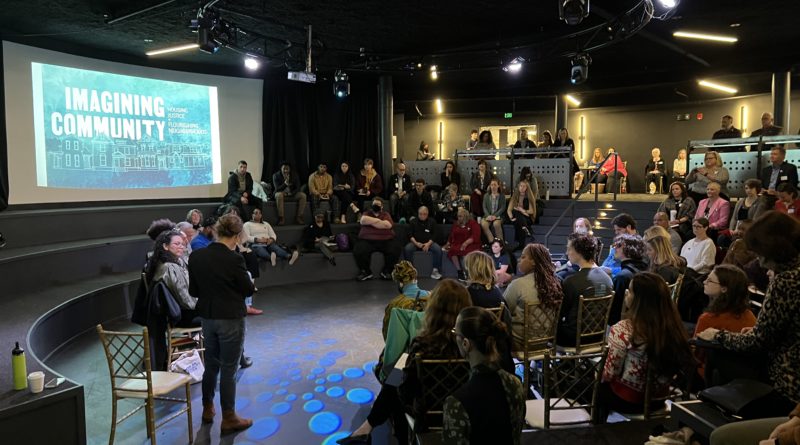Imagining a more inclusive community
The Dayton community met at the Tank in the Dayton Arcade to explore housing justice at the Imagining Community Symposium. Photo courtesy of Leslie Picca.
Tori Miller | News Editor
The Imagining Community Symposium isn’t just about dreaming of more inclusive housing, it is a direct plan of action. On Feb. 16-18 the second annual symposium— focused on housing justice and flourishing neighborhoods— invited everyone across the Dayton area to learn together.
The symposium acts as a space intended for community members across Miami Valley to come together through education and dialogue. Through art exhibits, workshops, panels and presentations, people in the greater Dayton area explored how housing affects health outcomes.
Building off the success of last year’s discussion on redlining in the Dayton region, University of Dayton faculty, staff and students furthered the conversation on housing injustice. In partnership with Dayton Metro Library, Sinclair Community College, Wright State University and other Dayton partners, the symposium was free and open to the public.
The symposium took place at the Hub Powered by PNC at the Dayton Arcade, with additional exhibits at the Dayton Metro Library and the Fitz Center for Leadership in Community. Attendees were highly encouraged to visit the Evicted exhibit which was inspired by Matthew Desmond’s Pulitzer Prize-winning book talking about the causes and impacts of evictions.
Included in the weekend’s agenda were three keynote speakers with different specializations. One of these speakers was Aaliyah Baker, an assistant professor of educational administration at UD, with her research focusing on establishing anti-racist communities of practice, cultural competence in higher education.
Leslie Picca, Roesch Library chair in the social sciences and professor of sociology, said that the first step to building a more inclusive and equitable society is to explore the realities hiding in plain sight. Housing connects to all aspects of life and where you live determines what resources—such as access to education— people have and can greatly impact health outcomes, she said.
“Housing really is central to many of our communities’ social problems,” Picca said. “We really need a lot of different voices to come together with a goal of having a more equitable area.”
While the gathering happened during Black History Month by chance, the symposium reinforced its significance through addressing housing issues in racial and ethnic communities.
Dayton is one of a handful of cities across the country labeled as hyper-segregated. Clear distinctions of racial divides— particularly between Black and white communities— due to wealth gaps in concentrated areas.
“Although we often think about Dayton as Black and white divide, we certainly can see the impact this has had on Asian Americans, Indigenous and Native American individuals, and Latinx communities,” Picca said.
Assistant professor of graphic design at UD and design director for the symposium Misty Thomas Trout said that housing is just one of the systems acting against marginalized groups and that understanding a wide range of backgrounds and lived experiences is important for growth.
“In order to continue to dismantle racism, we need to bring the community to the table on all systems that were built to oppress BIPOC individuals and families,” she said.
To help these racially diverse communities, the Dayton Human Relations Council coordinates and facilitates outreach programs to teach people about housing disparities. UD sophomore and HRC spokesperson Leonard Zaleski presented at the symposium, discussing communication strategies when raising housing issues or needs to the city of Dayton.
“I chose this topic because it combined the issue of housing justice and my passion for utilizing communications to help raise awareness of major issues,” Zaleski said.
The time to unite communities toward housing justice is now, he said. When dealing with the complex issues of disparities in housing, Dayton is continuing to take steps toward a more equal and inclusive community for future generations.
“Dayton is a united and tight knit city with tons of room to grow,” Zaleski said. “The symposium is a launch pad for the city to continue to incorporate housing into its planning and vision.”
For more information:
https://udayton.edu/artssciences/endowedchair/roesch/imagining-symposium.php
For more campus news, like Flyer News on Facebook and follow us on Twitter (@FlyerNews) and Instagram (@flyernews).

